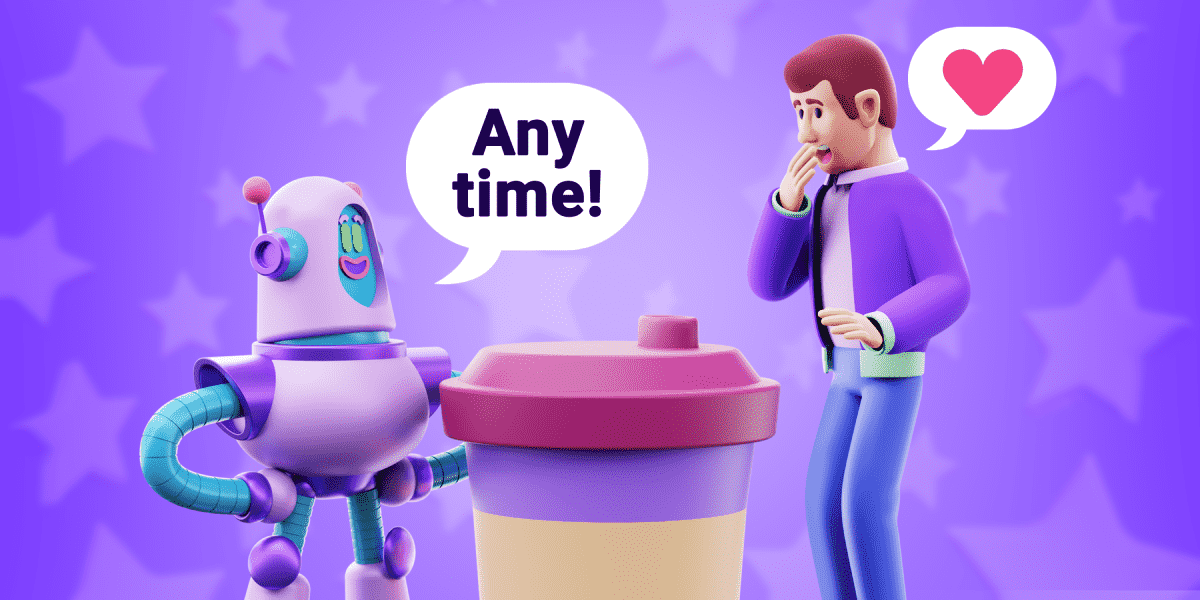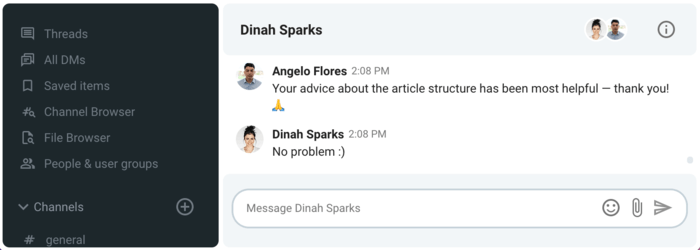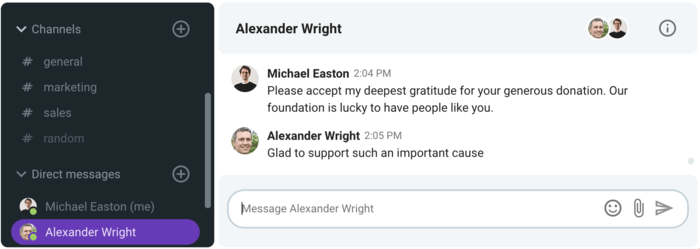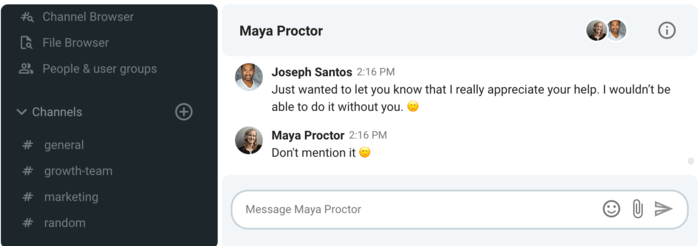Few things feel as good as hearing “Thank you” after lending someone a helping hand. This expression of gratitude is especially important in the workplace, where we sometimes face high-stress situations and unexpected circumstances.
Although we may feel down on our luck, having someone acknowledge our good deeds can be a powerful motivator, even if we haven’t done anything drastic.
However, that’s not where the exchange ends. Receiving praise and gratitude feels good, but responding with a heartfelt “You’re welcome” also matters.
Still, not everyone is sure how to respond to gratitude after giving away compliments, praise, and constructive feedback while on the job. Namely, saying “You’re welcome” feels a bit formulaic and can become repetitive.
But does that mean you should forego courteous manners and simply nod to acknowledge others? Well, while practical and straightforward, that is not the best approach.
So, next time you feel reluctant to say “You’re welcome,” you might want to think again.
And if you’re afraid of sounding repetitive — don’t worry.
In this blog post, we’ll look at why courteous manners make a difference for employees. We’ll also discuss alternative ways to say “You’re welcome” so your conversation never becomes monotonous.
Now, let’s dive in.

Table of Contents
Why expressing (and acknowledging) gratitude in your workplace matters
Although many workplaces have taken steps to engage their employees more, some people still view the work ecosphere as relying on transactional relationships.
After all, this strategy yields good results. You compile a report and share it with your teammates, who then forward it to your superiors.
The goal is clear — all of your interactions should bring the company one step closer to achieving its business goals.
However, does this justify failing to participate in small acts of kindness such as saying “Thank you” and “You’re welcome”? Well, research suggests otherwise.
This data analysis found that a culture of gratitude not only made employees feel better but improved their stress response as well.
In addition to these benefits, there are two more reasons why expressing gratitude on the job is a good idea.
Exchange messages of gratitude with your team over Pumble
Reason #1: Boosts employee engagement and motivation
Companies can invest in team-building events, improve benefits, and organize training sessions to show appreciation to employees. Still, in an environment where effective communication is a top priority, rarely is anything as motivating as a few kind words.
According to Robert Emmons, a researcher and psychology professor from Emmons Lab at UC Davis, gratitude is the ultimate “performance-enhancing substance” that “heals, energizes, and transforms lives.”
John Mackey, the CEO and founder of Whole Foods Market, echoes this sentiment, describing courteous behavior as “a virtuous cycle.”
When employees feel appreciated by coworkers and superiors, they’re more likely to bring that positive energy to the job and extend the same treatment to customers.
So, if satisfied employees equal satisfied customers, why break this virtuous cycle by failing to respond with “You’re welcome”?
Besides acting as a motivating factor, workplace gratitude compels people to participate in two-way communication, allowing them to achieve better results than their less engaged colleagues.
Research supports these claims. According to a study from the Harvard Business Review, incivility in the workplace can have detrimental effects on:
- Employee productivity,
- Loyalty, and
- Even company revenue.
Reason #2: Builds strong communal and interpersonal relationships
As we’ve described, gratitude plays a critical role in business success, but we’d be remiss not to mention its equally important human case.
Whether your company has opted for an in-office or a remote business model, you spend approximately one-third of your day interacting with others. Those who primarily work from offices spend up to 40 hours a week next to their coworkers, which makes building strong bonds with others all the more imperative.
Through positive interactions, we receive and give out recognition and appreciation, leading to meaningful connections, something everyone requires across all areas of life. In addition, repeated kindness eventually results in what has been called the “spillover” effect.
In short, a quick “Thank you,” “You’re welcome,” or “Good work” helps build trust between coworkers and makes them more likely to help others.
The standards of etiquette dictate that we should follow up expressions of gratitude with a polite “You’re welcome.” By failing to do so, you risk souring your relationships with coworkers and creating an atmosphere where others feel uneasy.
An uncomfortable employee experience may negatively impact customer experience, so it’s best to end these exchanges on a high note.
Of course, most people don’t want to be rude to their colleagues. But, more often than not, they’re struggling to find the right words.
Regarding business communication, many complain that using the same phrases makes conversations sound stiff, and you want to avoid boring your colleagues by repeating yourself too often.
The good news is that you don’t have to rely on overused words and phrases when responding to coworkers and collaborators. You can use numerous creative ways to say “You’re welcome” to enrich your vocabulary and make conversation a bit more interesting.
💡 Pumble Pro Tip
If you want to avoid the trap of business communication and weed out vague language for maximum clarity and transparency, check out this blog post:
General ways to say “You’re welcome” in a professional setting
Our words can leave a lasting impression on others, even if they can’t remember what was said. For example, a former colleague might remember your kindness years after working with you and call you up with an exciting new proposal.
Laying the groundwork for solid coworker relationships doesn’t have to be complicated. It only takes a few words here and there, and when it comes to saying “You’re welcome” in a professional setting, there’s no shortage of alternatives you can try.
So, when you catch yourself forming this overused phrase, take a step back and opt for one of the following responses:
“I’m happy I was able to be of assistance.”
“There is really no need.”
“I’m happy to help out with whatever I can.”
“It’s good to know you’re satisfied with the results.”
“It’s always a pleasure to support the team.”
“I only did my job, and I definitely want to be a good colleague.”
“Teamwork is one of our highest priorities.”
“Anything for the team.”
“I’m happy I got the opportunity to work with you on this project.”
The above responses are formal, making them an excellent choice when speaking in a business setting. They’re appropriate in multiple circumstances, including when:
- You want to let your manager know that you care about your assignments and tasks,
- You wish to show your colleague or superior that their feedback and opinion matter to you, and,
- You’ve received praise for your performance on a particular project.
💡 Pumble Pro Tip
Receiving praise is one thing, but expressing thanks is a different ballgame. If you find yourself on the other side of the conversation and wish to thank someone for their help, you might want to read this blog post and learn the best ways to say “Thank you” professionally:
Different ways to say “You’re welcome” professionally in an email
Professionals receive many emails each day, but your message won’t be lost in a sea of correspondence as long as you:
- Pay attention to the standard email structure,
- Get straight to the point, and
- Eliminate mistakes before hitting “Send.”
You should make sure to include the following elements in your professional “You’re welcome” email:
- Subject line: A short “My pleasure” or “Happy to be of assistance” is enough to set the tone of your email.
- Greeting: It will depend on how well you know the recipient. For coworkers you interact with on a daily basis, you can choose a more casual “Hi.” But, when addressing a manager or other superior, it’s best to stick to a formal “Greetings” or “Good day.”
- Body: This is the core of your email where you can say “You’re welcome.” You can also use this opportunity to thank the recipient for inviting you to work on a specific project or express that you appreciate they value your advice.
- Closing: Restate the message in the body of the email, highlighting that you’ll gladly come to the recipient’s aid at any time.
After mastering the above structure, you won’t have any issues crafting a well-written email expressing that you were happy to assist your coworker, team, or superior. And our example will guide you some inspiration.
An example of a professional “You’re welcome” email
So, how does this look in practice? Let’s see.
Hi, Katie,
I’m glad I could aid you in wrapping up the Washington project. Not only did I get a chance to share my knowledge with you, but I also learned so much valuable information from everyone involved. It was a fantastic experience, and I’m happy I could contribute to a milestone that will surely bring our team more success in the future.
If you ever need any advice on a particular issue, don’t hesitate to drop by my office or send me an email.
Sincerely,
John
💡 Pumble Pro Tip
For more ideas on how to craft a good professional email, see these blog posts:
Different ways to say “You’re welcome” professionally on a business communication app
Note that, while the above is a great example of a professional email, many companies are now choosing a hybrid or remote-first model. In these cases, long email chains don’t do much to bolster remote communication.
Consequently, businesses of all sizes have moved to communication apps like Pumble to improve employee engagement and productivity. If this situation sounds familiar, you may be wondering how to respond after seeing a “Thank you” message land in your DM.
For the most part, team communication apps provide more wiggle room, which means you can easily adjust your tone and switch between formal and informal conversation, depending on with whom you’re corresponding.
For example, take a look at the following exchange.

Dinah responded with a quick “No problem” and added a smiley face. It’s a simple, friendly message that gets the job done and acknowledges Angelo’s gratitude.
On the other hand, the below exchange has a more formal tone.

Before sending the “You’re welcome” variation of your choice, reread the “Thank you” message and try to match its tone.
💡 Pumble Pro Tip
Work message skills ensure hassle-free communication with coworkers, superiors, and clients. So, whether you’re attempting to write a superb email or a polite message in a team communication app, your words matter. To see how to enhance productivity and eliminate misunderstandings, check out this blog post:
Perfect your work message skills with Pumble
Additional ways of saying “You’re welcome” after helping a coworker
All successful businesses rely on collaboration to scale their operations. You’ve likely worked with many people who’ve valued your help or advice.
They may have even expressed their appreciation through a thoughtful card or a heartfelt message, leaving you dumbfounded about what to reply instead of the basic “You’re welcome.”
Should you find yourself in a similar situation, you’ll be well-prepared and able to choose from the responses we’ve already discussed.
Of course, if you need some more inspiration, there are other ways to say “You’re welcome,” including:
“Thank you for reaching out. Glad I could help you out!”
“I appreciate your kind words. Know that you can reach out whenever you require assistance.”
“I’m glad I could help you overcome this hurdle. I assure you, the pleasure was all mine.”
“That’s what good colleagues are for.’
“It’s always amazing when I get to work with driven and talented individuals.”
If you have a close relationship with a teammate and know them on a deeper level, responding in a formal manner can sound staged and unnatural. In these scenarios, it’s okay to go for a more casual approach and respond with:
“You’d do the same thing for me, so don’t mention it.”
“Anytime!”
“Absolutely!”
“No worries.”
“Not a problem.”

Casual and funny ways to say “You’re welcome”
Professionalism and a good reputation are goals many strive for on the job, but unfortunately, humor seems to get lost in the shuffle. However, research suggests that there is indeed a place for humor patterns in the workplace.
- Group and individual performance,
- Employee well-being, and
- Employee satisfaction.
Namely, this 2014 Lehmann-Willenbrock and Allen study found that human interactions, such as humorous exchanges, positively impacted:
So, next time you bite your tongue when you think of a funny “You’re welcome” variation, you might as well go for it and put everyone around you in a good mood.
As long as your response is free from inappropriate language, there’s no reason why you shouldn’t use it to get a chuckle out of a coworker. When properly managed, informal or grapevine communication can improve business operations in several ways.
But now that you’re trying to think of casual and funny ways to say “You’re welcome,” your mind’s drawing a blank. Luckily, one of the below options should do the trick both in-person and during virtual calls:
“Remember this when voting in the election.”
“Oh, just leave me your address, and I’ll send you the bill.”
“I’m more than happy to give you an autograph.”
“I merely held the door open for you.”
“You know you can count on me to lighten the load.”
💡 Pumble Pro Tip
Daily virtual calls have become a reality for many professionals, often leaving them drained and exhausted. To learn how to add a dash of humor and fun to these meetings and boost employee engagement, check out this blog post:
Express yourself better with Pumble
Expressing and acknowledging gratitude works wonders in a professional setting. So, long as your words and attitude are genuine, there’s no need to hesitate when responding with “You’re welcome.”
If your team uses Pumble, a team communication and collaboration app, you’ll be able to quickly send acknowledgement to your coworkers’ gratitude.
Depending on the situation, you can:
- Respond to a direct message or a channel message mentioning you,
- React to the message with an emoji (or even a custom emoji), or
- Give the person a quick audio or video call, if necessary.
You can use some of the above phrases when you feel the conversation might get too monotonous or use them as inspiration to come up with original responses.







